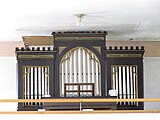Martin Binder
Martin Binder (born October 17, 1849 in Ilmmünster ; † August 1, 1904 in Regensburg ) was a German organ builder.
life and work
Martin Binder was born in Ilmmünster on October 17th. After leaving school around 1862/63 at the age of 14, he learned the trade of carpenter . In 1865 he went on a hike and learned the trade of organ builder. Exactly where he was active is not known. But he must have been with Max Maerz too, because at that time this was the only progressive company that was already dealing with cone shops at that time . Binder founded an organ building company in Pfaffenhofen an der Ilm in 1875, which he and his brother-in-law Willibald Siemann moved to Regensburg in 1890 , in the area of the eastward expansion of the city of Regensburg, to Villastrasse 2. From this point on, the company traded as "Binder & Siemann". In 1900 the company was separated: the Munich plant operated under the name “Siemann & Co” and the main plant in Regensburg “Martin Binder & Son”, since Binder's son Eugen joined the company in 1895. By the time the company's founder died in 1904, the company had built 140 organs, mostly with a pneumatic cone chest. Eugen Binder, who died around 1957, succeeded him until he moved to America in 1909. From then on, the company in Regensburg only acted as a subsidiary of "Willibald Siemann" & Co.
List of works by own works (selection)
| year | opus | place | building | image | Manuals | register | Remarks |
|---|---|---|---|---|---|---|---|
| 1875 | 1 | Haindling | Pilgrimage Church of the Assumption |

|
I / P | 6th | In the case of Brandenstein (1730). Not received. Successor instrument 1914 from Weise no longer playable in 2016. |
| 1880? | - | Moosham (Mintraching) | St. Peter and Clement |

|
I / P | 9 | Without opus number, mechanical cone drawer, built by Martin Binder, Regensburg, according to the company sign
→ Special feature of the organ |
| 1881 | 3 | Niederscheyern | Annunciation | I / P | 8th | ||
| 1883 | 4th | Hohenwart | Annunciation (Market Church) |

|
I / P | 9 | not received; replaced by a digital sacred organ |
| 1884 | 5 | Winds | Virgin Mary's birth |

|
I / P | 9 | |
| 1885 | 8th | Johanneck | Assumption Day |

|
I / P | 9 | mechanical cone drawer , |
| 1886 | 10 | Tegernbach | Virgin Mary Purification |

|
II / P | 14th | Disposition changed and switched to electro-pneumatic action |
| 1887 | 12 | Pfaffenhofen an der Ilm -Kleinreichertshofen | Ortisei | I / P | 6th | ||
| 1888 | 14th | Gittenbach | I / P | 4th | not received | ||
| 1888 | 15th | Deimhausen | St. Pantaleon |

|
I / P | 9 | mechanical cone drawer , plant stored; currently replaced by a digital sacred organ |
| 1889 | 16 | Pfaffenhofen an der Ilm - old town | St. Andrew | I / P | 7th | ||
| 1889 | 17th | Ernsgaden | St. Laurence |

|
I / P | 9 | |
| 1889 | 18th | Wolfersdorf | St. Peter and Paul |

|
I / P | 9 |
As described above, Martin Binder always ran the company together with Willibald Siemann from 1890 onwards. From this point on it is therefore difficult to name the builder exactly. Therefore, further organs can be found in the Siemann work list .
literature
- Georg Brenninger: Organs in Old Bavaria . GeraNova Bruckmann, 1982, Munich ISBN 3-7654-1859-5
- Eberhard Kraus: Historic organs in the Upper Palatinate. Schnell & Steiner, Munich 1990, ISBN 3-7954-0387-1
- Christian Vorbeck: The organ builders Martin Binder and Willibald Siemann. A contribution to organ building in the time of the German late romanticism. Siebenquart, Cologne 2013, ISBN 978-3-941224-02-5 .
Web links
- Martin Binder in the Bavarian Musicians' Lexicon Online (BMLO)
| personal data | |
|---|---|
| SURNAME | Binder, Martin |
| BRIEF DESCRIPTION | German organ builder |
| DATE OF BIRTH | October 17, 1849 |
| PLACE OF BIRTH | Ilmmünster |
| DATE OF DEATH | August 1, 1904 |
| Place of death | regensburg |
